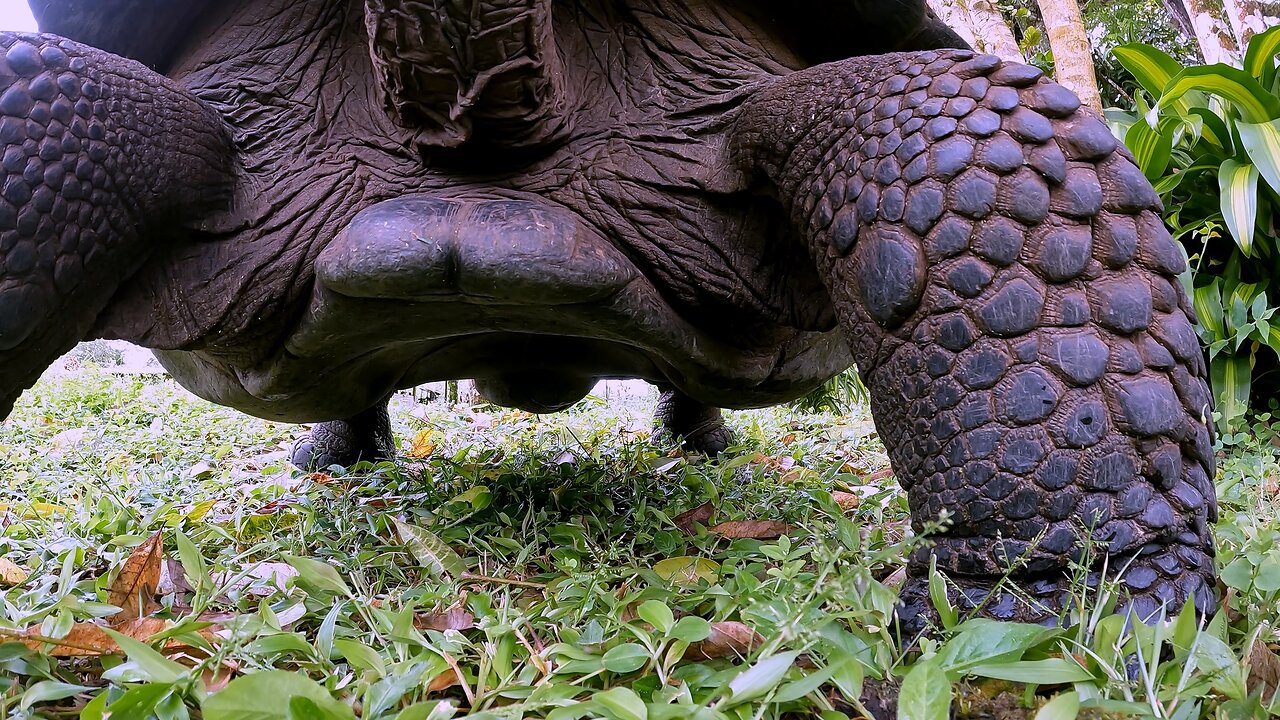Premium Only Content

Giant Galapagos Tortoise Stampedes Over Action Camera AT Full Speed
Galapagos Tortoises are among the most iconic animals in the world. Extremely rare, they exist naturally only on the Galapagos Islands, a province of Ecuador. Of the original 15 species of giant tortoise discovered, only 15 remain and most are critically endangered. They live longer than any other vertebrate and can store enough water to survive for up to a year without eating or drinking. It is this ability that made it possible for their ancestors to survive the trip from Africa long ago.
The Galapagos Islands were made famous when Charles Darwin visited in 1835 and studied the animals and birds, finding that they had uniquely adapted to life on each island. Their isolation led to physical changes in a species that allowed them to thrive under different conditions. It was this adaptation that inspired and shaped Darwin's theory of evolution that changed the way we looked at the world and at ourselves.
This giant tortoise weighs over 500lbs and measures roughly five feet across. He could be as old as 200 years. They are believed to live to well over 150 years of age and it is possible that some of the giants we see today were actually alive at the time of Darwin's famous visit to the islands. This big tortoise will spend the majority of his day grazing on almost any ground vegetation that grows here, as well as low hanging leaves. Ancient and majestic, they move slowly, but with determination. A camera set up on a path to record this great beast from a distance provided a unique view when he decided to walk right up to and over it. He knocks the camera over with his enormous leg.
Darwin saw that the tortoises on the islands shared many characteristics, yet displayed key differences. He theorized that they had been descended from the same species found on the mainland and other continents, but that they had changed over time to survive. The Galapagos Tortoises had developed a large indentation in their shell that allows them to stretch their long necks to reach higher vegetation, a critical adaptation for life in this hostile, yet beautiful environment where food is scarce during dry seasons.
Darwin found similar adaptations in finches that made the birds on each island unique from each other, despite being the same species. All of this pointed to the conclusion that animals underwent a process of physical change over generations that made them unique from one island to another. They key to this discovery was the isolation. The islands had formed from volcanic eruptions, some of which as recently as 700,000 years ago. The animals had no way to migrate the great distance between islands. They are believed to have arrived by floating rafts of vegetation moved by the varied and powerful currents that converge around the Galapagos Islands. Descended from the same species, yet different from their relatives on the neighboring islands, evolution was the only explanation. It was this discovery that led us to the understanding that we are descended from primates. Without Darwin's research, we had no understanding of our own origins. It was this research that changed the world in many ways.
Darwin's research also led to the understanding that the Galapagos Islands hold many keys to our understanding of the world. Islands shifting on tectonic plates, like an enormous conveyor belt, they are young in comparison to other islands. So close to the equator, they hold an enormously diverse collection of animals and plants that have much to teach us.
Many people have heard of the Galapagos Islands, and a lucky few have visited them. Seeing the Galapagos Tortoise is a significant and memorable experience for many who have been so fortunate.
-
 2:08
2:08
WildCreatures
1 month ago $1.74 earnedScuba Diver is Surrounded by Gigantic Green Sea Turtles
3.72K5 -
 10:02
10:02
MichaelBisping
13 hours agoBISPING: "Was FURY ROBBED?!" | Oleksandr Usyk vs Tyson Fury 2 INSTANT REACTION
2.66K6 -
 8:08
8:08
Guns & Gadgets 2nd Amendment News
2 days ago16 States Join Forces To Sue Firearm Manufacturers Out of Business - 1st Target = GLOCK
50.9K51 -
 10:17
10:17
Dermatologist Dr. Dustin Portela
1 day ago $6.35 earnedOlay Cleansing Melts: Dermatologist's Honest Review
53.6K -
 1:02:20
1:02:20
Trumpet Daily
1 day ago $26.68 earnedObama’s Fake World Comes Crashing Down - Trumpet Daily | Dec. 20, 2024
27.3K34 -
 6:29
6:29
BIG NEM
21 hours agoCultivating God Mode: Ancient Taoist NoFap Practices
21.2K6 -
 30:53
30:53
Uncommon Sense In Current Times
1 day ago $6.01 earned"Pardon or Peril? How Biden’s Clemency Actions Could Backfire"
50.6K2 -
 40:01
40:01
CarlCrusher
19 hours agoSkinwalker Encounters in the Haunted Canyons of Magic Mesa - ep 4
47K2 -
 59:44
59:44
PMG
1 day ago $4.29 earned"BETRAYAL - Johnson's New Spending Bill EXPANDS COVID Plandemic Powers"
50.2K19 -
 6:48:50
6:48:50
Akademiks
17 hours agoKendrick Lamar and SZA disses Drake and BIG AK? HOLD UP! Diddy, Durk, JayZ update. Travis Hunter RUN
172K28